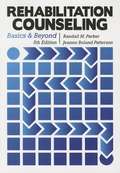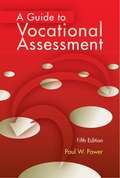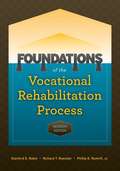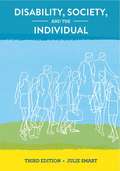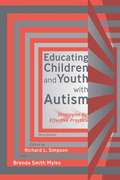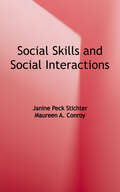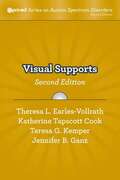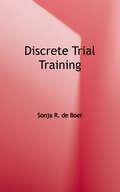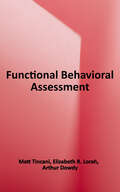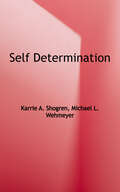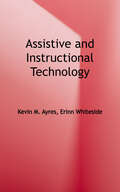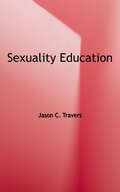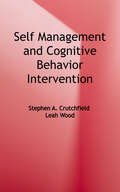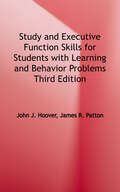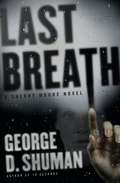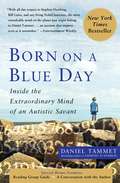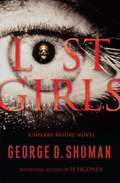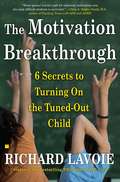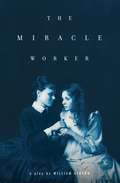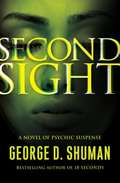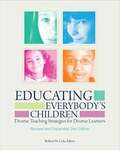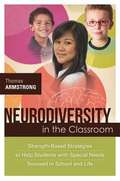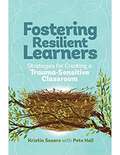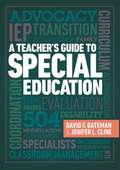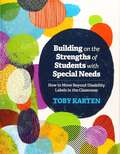- Table View
- List View
Rehabilitation Counseling: Basics And Beyond
by Randall M. Parker Jeanne Boland PattersonThe purpose of this text is to provide both a basic foundation for students beginning their journey into the profession of rehabilitation counseling and a broad-based reference for current practitioners. The contents provide a conceptual overview of the profession, history, theory, research, and applied foundations of rehabilitation counseling.
A Guide to Vocational Assessment 5th Edition
by Paul W. PowerThis fifth edition of A Guide to Vocational Assessment acknowledges the changes in social and economic systems facing adults with disabilities. It suggests multiple evaluation approaches and insights that can be used to change the difficult to the possible and eventually to the probable. While many chapters underscore the use of traditional evaluation approaches, other chapters operationalize vocational assessment as an individualized, creative, empowering, holistic process and experience of self-discovery.
Foundations Of The Vocational Rehabilitation Process
by Stanford E. Rubin Richard Roessler Phillip D. RumrillThe seventh edition of Foundations of the Vocational Rehabilitation Process provides historical, philosophical, legislative, and sociological foundations for the habilitation/rehabilitation of persons with disabilities. A thorough and current introduction to the American vocational rehabilitation process, this edition addresses mandates presented in the current major pieces of disability legislation influencing the practice of rehabilitation.This book presents theoretical and practical assistance in translating those mandates into positive action. It is this dual process of individual and environmental proactivity that can maximize the rehabilitation of disabled individuals. Not just for the dedicated rehabilitation counselor, this book is also for students attending an introductory course at the master's- or senior-level and in-service directors who design informative training programs. New in the seventh edition:Updated chapter on how "The Americans with Disabilities Act" (ADA), as amended in 2008, prohibits discrimination on the basis of disability in employment, public services, accommodations, and telecommunications. Updated section on the right to medical treatment in light of the 2012 "Affordable Care Act" (ACA). New information and updated references were added on the five disability types--physical disabilities, emotional disorders, intellectual disabilities, learning disabilities, and visual impairments and blindness. Now includes more than 1300 references, 300 of which are new.
Disability, Society, and the Individual
by Julie SmartThis unique book provides a comprehensive examination of the disability experience. The content focuses on definitions of disability, societal response to people with disabilities, and the experience of disability from the perspectives of individuals with disability. It is organized around broad themes rather than disability categories. With an engaging writing style and extensive and completely updated references, Disability, Society, and the Individual-Third Edition prepares the reader to understand and be able to use complex, important, and new ideas surrounding disability -- its experience and social and cultural context. The text includes discussion questions, learning activities, suggested readings, and first-person accounts. PART I--Definitions of Disability PART II--Society and Disability PART III--The Individual and Disability
Educating Children And Youth With Autism: Strategies For Effective Practice
by Richard L. Simpson Brenda Smith MylesChildren and youth with autism spectrum disorders (ASD) have highly distinctive and idiosyncratic needs and characteristics. ASD is an especially challenging and perplexing disability. The need for knowledgeable and skilled educational professionals was the primary motivation for preparing this third edition of Educating Children and Youth With Autism: Strategies for Effective Practice. This edition includes chapters written by internationally recognized authorities on ASD.
Social Skills and Social Interactions
by Janine Peck Stichter Maureen A. ConroySocial Skills and Social Interactions is written to enhance the quality and quantity of social interactions of individuals with autism spectrum disorder (ASD) and their peers. The text describes social competence and peer-related social behaviors, a multisource functional approach to assessment, and evidence-based practices for fostering peer-related social interactions. This book provides a systematic process for educators to assess, plan for, and support students' social behaviors with peers in the classroom.
Visual Supports
by Theresa L. Earles-VollrathVisual supports are essential components of programs serving students with autism spectrum disorders (ASD) and can help provide a variety of information that enables these students to better understand and complete tasks with greater independence. Visual Supports, Second Edition provides information to help educators and families utilize visual displays or cues, such as schedules, boundaries, labels, and consequence maps, to help students with ASD achieve improved learning outcomes. Contents 1. Creating Visual Supports for Students With Autism Spectrum Disorders 2. Visual Supports That Provide Information 3. Visual Strategies That Support Behavior and Emotional Regulation 4. Visual Supports That Structure the Learning Environment 5. Visual Supports That Enhance Cognition and Language Development 6. Visual Supports That Enhance Comprehension of Classroom Instruction 7. Visual Strategies That Support Conversation and Social Skills
Discrete Trial Training
by Sonja R. DeBoerDiscrete trial training (DTT) is a method of teaching individuals with autism spectrum disorder (ASD) based on applied behavior analysis (ABA). Skills are broken into discrete steps and then taught in massed trials. With DTT, steps are taught one at a time, instead of teaching an entire skill all at once. Concepts covered include errorless learning, methods of reinforcement, and how to use behavior momentum. The text explains how to collect, interpret, and use data to make teaching decisions. Finally, the text details a method for evaluating implementation of DTT.
Functional Behavioral Assessment
by Matt Tincani Elizabeth R. Lorah Arthur DowdyDescribes how to conduct functional behavioral assessment (FBA) as an information-gathering process to develop successful function-based intervention plans for children and youth with autism spectrum disorder (ASD)
Self-Determination
by Karrie Ann Shogren Michael L. WehmeyerThis book offers specific and clearly described strategies for teaching learners with ASD to become more self-determined in their actions regarding their educational program plans and outcomes.
Assistive and Instructional Technology
by Kevin M. Ayres Erinn WhitesideAssistive and Instructional Technology is a guide to using technology in the classrooms of students with autism spectrum disorder. This book describes the difference between assistive and instructional technology and how they are related. It identifies key features to look for in new technology and provides step-by-step support for using it effectively. This succinct resource describes critical aspects of current technology that result in improved learning outcomes.
Sexuality Education (PRO-ED Series on Autism Spectrum Disorders, Second Edition)
by Jason C. Travers"This book promotes the use of a behavior analytic approach and encourages and supports the provision of comprehensive sexuality education (CSE) for healthy and safe sexual development of learners with autism"
Self-Management and Cognitive Behavior Interventions
by Stephen A. Crutchfield Leah WoodSelf-Management and Cognitive Behavior Interventions is a guide to using cognitive behavior modification (CBM) with students with autism spectrum disorder (ASD) to increase the student's self-management. CBM approaches include self-management intervention (SMI) and cognitive behavior intervention (CBI). SMI is synonymous with self-regulation and encompasses a variety of cognitive processes, such as controlling emotions, attending to relevant information, planning future behavior, remaining flexible through unplanned setbacks, and behaving in a way that enhances the likelihood of achieving future goals. SMI is managed by the student and is used to address a wide variety of target behaviors. CBI helps individuals examine their thoughts and emotions and adopt actions that change their thinking as well as their behavior. This book examines specific, research-based cognitive behavior interventions and self-management interventions and explores designing and implementing interventions for students with ASD.
Study and Executive Function Skills for Students with Learning and Behavior Problems: A Practitioner's Guide
by John J. Hoover James R. Patton"This book focuses on study skills and executive function skills for students in grades K-12 who are struggling learners, including those with executive function disorder, dyslexia, and ADHD, to help them with their learning and behavior problems". --Provided by publisher.
Last Breath: A Sherry Moore Novel
by George D. ShumanFollowing close on the heels of his celebrated debut 18 Seconds, George Shuman returns with yet another remarkable thriller featuring investigative consultant Sherry Moore -- a blind woman with an uncanny ability to view the final living moments of any dead body she encounters. A ruthless serial killer with an unthinkable MO has left a trail of tortured, murdered women in western Maryland and seems to have gone to ground in the backwoods of Pennsylvania. With no leads or any sign of a suspect, investigators must call on the now-famous blind psychic Sherry Moore, a woman whose talent inspires skepticism, but whose results are unparalleled. When she is put in contact with the hand of any dead body, she relives the memory of the departed's final experience. While investigating this case, she is privy to the most savage and terrifying scenes imaginable. However, because the killer is aware of her methods, he keeps his identity just beyond her reach until she resolves to put herself directly in harm's way. When the fiend sets his sights on Sherry, this seemingly helpless woman must demonstrate an almost inhuman strength of will and of body as she attempts to capture the deranged killer without having to pay the ultimate price in exchange. With Last Breath, George Shuman confirms his status as one of the most captivating thriller writers, and in Sherry Moore, he presents one of the most compellingly original protagonists the genre has ever seen.
Born on a Blue Day: Inside the Extraordinary Mind of an Autistic Savant
by Daniel TammetBorn on a Blue Day is a journey into one of the most fascinating minds alive today -- guided by its owner himself. Daniel Tammet sees numbers as shapes, colors, and textures, and he can perform extraordinary calculations in his head. He can learn to speak new languages fluently, from scratch, in a week. In 2004, he memorized and recited more than 22,000 digits of pi, setting a record. He has savant syndrome, an extremely rare condition that gives him almost unimaginable mental powers, much like those portrayed by Dustin Hoffman in the film Rain Man. Daniel has a compulsive need for order and routine -- he eats the same precise amount of cereal for breakfast every morning and cannot leave the house without counting the number of items of clothing he's wearing. When he gets stressed or is unhappy, he closes his eyes and counts. But in one crucial way Daniel is not at all like the Rain Man: he is virtually unique among people who have severe autistic disorders in that he is capable of living a fully independent life. He has emerged from the "other side" of autism with the ability to function successfully -- he is even able to explain what is happening inside his head. Born on a Blue Day is a triumphant and uplifting story, starting from early childhood, when Daniel was incapable of making friends and prone to tantrums, to young adulthood, when he learned how to control himself and to live independently, fell in love, experienced a religious conversion to Christianity, and most recently, emerged as a celebrity. The world's leading neuroscientists have been studying Daniel's ability to solve complicated math problems in one fell swoop by seeing shapes rather than making step-by-step calculations. Here he explains how he does it, and how he is able to learn new languages so quickly, simply by absorbing their patterns. Fascinating and inspiring, Born on a Blue Day explores what it's like to be special and gives us an insight into what makes us all human -- our minds.
Lost Girls: A Sherry Moore Novel
by George D. ShumanIn Lost Girls, bestselling author George D. Shuman's riveting new thriller, beautiful blind psychic Sherry Moore becomes embroiled in her most perilous and disturbing case to date and finds that the lives of hundreds of women hang in the balance. Sherry Moore would do anything for her confidant and best friend, retired Admiral Garland Brigham. So when he suddenly asks her to assist a team of U.S. Navy SEALs in a daring high-altitude rescue on Mount McKinley, she doesn't hesitate and soon finds herself flying across the country to hang vertically off an Alaskan cliff, tethered to Captain Brian Metcalf. Sherry, renowned for her ability to see the last eighteen-seconds of a deceased person's memory, takes the hand of a dead climber, hoping to ascertain the whereabouts of his missing climbing team. But what she sees leaves her with visions that will haunt her long past Alaska. While rumors of slave girls being trafficked around the Caribbean have circulated for years, little credible evidence has been uncovered about these "lost girls." When detective inspector Roily King George recovers the body of a young blond woman, naked except for a shocking tattoo branded onto her cheek, he knows she may hold the key to toppling this criminal underworld. Through delicate back-channel negotiations, Sherry arrives in Kingston, Jamaica, to see the deceased and finds that things are more complicated than she thought: the remains are of Jill Bishop, an American teenager last seen in a Santo Domingo marketplace. Carol Bishop, relentless in her pursuit to.find out how her daughter died, and Sherry, the distressing images from Mount McKinley still fresh in her memory, embark on a frantic hunt for clues from the Dominican Republic to the remote jungles of Haiti, racing against time to save others from Jill's fate. Along the way, Sherry must confront a legendary voodoo priest, who possesses abilities eerily similar to her own, and take on a man whose depraved practices give new meaning to the word evil.
The Motivation Breakthrough: 6 Secrets to Turning On the Tuned-out Child
by Richard LavoieAny child can be motivated to learn. "If he only would apply himself..." "She can do it if she puts her mind to it." "He just doesn't seem to care." "She's just not trying." Motivation is the key to learning. But very few parents and teachers have an effective arsenal of techniques at their disposal. Enter educator and acclaimed author Rick Lavoie, who arms all those who deal with children with proven, effective tools and strategies they can use to encourage any child to learn and achieve success. Lavoie's practical, innovative approach begins with a quiz that helps a parent or teacher identify -- using six different possible models -- a child's motivational style. Is she motivated by power? Does he need prestige? Does praise mean a lot to this child? Does contact with other people inspire this child? Does he like to do projects? Does she enjoy receiving prizes? He then explores each motivational style in depth, presenting proven techniques, strategies, and scripts that can be used in the classroom and at home to break through a child's apathy and discouragement and inspire him to succeed and achieve. Along the way, Lavoie explodes some common myths about motivation: for instance, he demonstrates that rewards, punishment, and competition are not effective motivational tools. He gives specific advice throughout for parents and teachers of children with learning disabilities and provides detailed instructions for how to create a motivated classroom. He outlines the parent's role, the teacher's role, and suggests ways in which they can work together to encourage children to reach their potential. The book's final chapter, "What Does Madison Avenue Know...That Maple Street Elementary School Doesn't," reveals what parents and teachers can learn from some of the most powerful motivators in our children's world: advertisers. With empathy and understanding, backed by decades of experience in the classroom, Rick Lavoie gives parents and teachers the key to unlock any child's enthusiasm and responsiveness. The Motivation Breakthrough will revolutionize the way parents, teachers, and professionals reach out to and motivate all children.
The Miracle Worker: A Play
by William GibsonNO ONE COULD REACH HER Twelve-year-old Helen Keller lived in a prison of silence and darkness. Born deaf, blind, and mute, with no way to express herself or comprehend those around her, she flew into primal rages against anyone who tried to help her, fighting tooth and nail with a strength born of furious, unknowing desperation. Then Annie Sullivan came. Half-blind herself, but possessing an almost fanatical determination, she would begin a frightening and incredibly moving struggle to tame the wild girl no one could reach, and bring Helen into the world at last....
Second Sight: A Novel of Psychic Suspense
by George D. ShumanStunningly beautiful psychic Sherry Moore's world has been draped in darkness for as long as she can remember. Though she has been blind since childhood, her extraordinary gift for seeing the last eighteen seconds of a deceased person's memory has helped solve numerous crimes and save countless lives. Her life has been anything but normal, but because of her relationship with Brian Metcalf, the Navy SEAL she met during a dramatic rescue on Mount McKinley, Sherry has never been happier. Then her exposure to deadly radiation changes everything. Unnerved about the radiation's possible aftereffects and suffering from optical migraines, Sherry checks herself into the hospital to undergo tests. All seems normal until they wheel in the body of one Thomas Monahan. Vivid, terrifying images from his memory flood her thoughts the moment she grasps his hand. She feels a connection take hold as she thrashes about on the gurney, finally letting out a bloodcurdling scream. When Sherry next opens her eyes, for the first time in thirty-two years, she can see. They call it a miracle. But for Sherry life with sight proves to be more complicated. She has to navigate the world anew, troubled by the agonizing, unanswered question: Who was this man and how had he enabled her to regain her vision? Enlisting the help of retired Admiral Garland Brigham, her confidant and best friend, Sherry doggedly begins to unravel this complicated history and unearths some startling revelations, beginning with the work of Edward Case. Case is a man used to getting his way. The CEO of pharmaceutical giant Case & Kimble, he has the nation's elite on speed dial. But unsettling rumors have circulated for years about the genesis of the company's stratospheric success, questioning how this upstart firm has gained prominence and grown to be a monolithic institution worth billions of dollars. How its drugs always seem to make it onto the market before those of its competitors. If the secrets to C&K's dominance are ever made public, they will destroy the empire Case has so carefully constructed. And he will stop at nothing to keep his domain intact. Flush with pounding action and shocking twists, Second Sight is the riveting story of an astounding heroine who, in delving into the darkest corners of the pharmaceutical trade, risks her life to set right an injustice buried deep in the past.
Educating Everybody's Children: Diverse Teaching Strategies for Diverse Learners
by Robert W. ColeDesigned to promote reflection, discussion, and action among the entire learning community, Educating Everybody's Children encapsulates what research has revealed about successfully addressing the needs of students from economically, ethnically, culturally, and linguistically diverse groups and identifies a wide range of effective principles and instructional strategies. <p><p> Although good teaching works well with all students, educators must develop an extensive repertoire of instructional tools to meet the varying needs of students from diverse backgrounds. Those tools and the knowledge base behind them are the foundation of this expanded and revised second edition of Educating Everybody's Children. Each strategy discussed in the book includes classroom examples and a list of the research studies that support it. <p><p> The most important thing we have learned as a result of the education reform movement is that student achievement stands or falls on the motivation and skills of teachers. We must ensure that all teachers are capable of delivering a standards‑based curriculum that describes what students should know and be able to do, and that these standards are delivered by means of a rich and engaging "pedagogy of plenty." By these two acts we can ensure that all schools will be ready and able to educate everybody's children.
Neurodiversity in the Classroom: Strength-Based Strategies to Help Students with Special Needs Succeed in School and Life
by Thomas ArmstrongA new concept on human diversity has emerged over the past 10 years that promises to revolutionize the way educators provide services to students with special needs: neurodiversity. Just as we celebrate diversity in nature and cultures, so too do we need to honor the diversity of brains among our students who learn, think, and behave differently. In Neurodiversity in the Classroom, best-selling author Thomas Armstrong argues that we should embrace the strengths of such neurodiverse students to help them and their neurotypical peers thrive in school and beyond. This innovative book focuses on five categories of special needs: learning disabilities, attention deficit hyperactivity disorder, autism, intellectual disabilities, and emotional and behavioral disorders.
Fostering Resilient Learners: Strategies for Creating a Trauma-sensitive Classroom
by Kristin Souers Pete HallIn this galvanizing book for all educators, Kristin Souers and Pete Hall explore an urgent and growing issue--childhood trauma--and its profound effect on learning and teaching. <P><P> Grounded in research and the authors' experience working with trauma-affected students and their teachers, Fostering Resilient Learners will help you cultivate a trauma-sensitive learning environment for students across all content areas, grade levels, and educational settings. The authors--a mental health therapist and a veteran principal--provide proven, reliable strategies to help you <P><P> * Understand what trauma is and how it hinders the learning, motivation, and success of all students in the classroom. * Build strong relationships and create a safe space to enable students to learn at high levels. * Adopt a strengths-based approach that leads you to recalibrate how you view destructive student behaviors and to perceive what students need to break negative cycles. * Head off frustration and burnout with essential self-care techniques that will help you and your students flourish. <P><P> Each chapter also includes questions and exercises to encourage reflection and extension of the ideas in this book. As an educator, you face the impact of trauma in the classroom every day. Let this book be your guide to seeking solutions rather than dwelling on problems, to building relationships that allow students to grow, thrive, and--most assuredly--learn at high levels.
A Teacher's Guide to Special Education
by David Bateman Jenifer ClineDespite the prevalence of students with disabilities in the general education classroom, few teachers receive training on how to meet these students' needs or how to navigate Despite the prevalence of students with disabilities in the general education classroom, few teachers receive training on how to meet these students' needs or how to navigate the legally mandated processes enumerated in the Individuals with Disabilities Education Act (IDEA). What is their role? What are their responsibilities? What are the roles and rights of parents? And what must all teachers do to ensure that students with disabilities and other special needs receive the quality education they're entitled to? In this practical reference, David F. Bateman--bestselling author of A Principal's Guide to Special Education --and special education administrator Jenifer L. Cline clarify what general education teachers need to know about special education law and processes and provide a guide to instructional best practices for the inclusive classroom. Topics covered include The pre-referral, referral, and evaluation processes Individualized education programs (IEPs) and the parties involved Accommodations for students who do not quality for special education, including those covered by Section 504 Transition from preK to K-12 and from high school to postschool life Classroom management and student behavior Educational frameworks, instructional strategies, and service delivery options Assessment, grades, graduation, and diplomas The breadth of coverage in this book, along with its practical examples, action steps, and appendixes covering key terms and definitions will provide the foundation all K-12 teachers need to successfully instruct and support students receiving special education services. It's an indispensable resource for every general education classroom. the legally mandated processes enumerated in the Individuals with Disabilities Education Act (IDEA). What is their role? What are their responsibilities? What are the roles and rights of parents? And what must all teachers do to ensure that students with disabilities and other special needs receive the quality education they're entitled to? In this practical reference, David F. Bateman--bestselling author of A Principal's Guide to Special Education --and special education administrator Jenifer L. Cline clarify what general education teachers need to know about special education law and processes and provide a guide to instructional best practices for the inclusive classroom. Topics covered include The pre-referral, referral, and evaluation processes Individualized education programs (IEPs) and the parties involved Accommodations for students who do not quality for special education, including those covered by Section 504 Transition from preK to K-12 and from high school to postschool life Classroom management and student behavior Educational frameworks, instructional strategies, and service delivery options Assessment, grades, graduation, and diplomas The breadth of coverage in this book, along with its practical examples, action steps, and appendixes covering key terms and definitions will provide the foundation all K-12 teachers need to successfully instruct and support students receiving special education services. It's an indispensable resource for every general education classroom.
Building on the Strengths of Students with Special Needs: How to Move Beyond Disability Labels in the Classroom
by Toby KartenAs a must-have reference for busy teachers with little special education training, this book supplies classroom-tested instructional strategies that address the characteristics of and challenges faced by students with special needs. Dozens of differentiated strategies target teachers’ anxieties and provide responsive interventions that can be used to address specifics of IEPs and learning plans. <p><p>With Building on the Strengths of Students with Special Needs, special education expert Toby Karten focuses on specific disabilities and inclusive curriculum scenarios for learners in K–12 environments. She offers valuable advice on how to prevent labels from capping student potential and encouragement to help teachers continually improve learner outcomes. <p><p>By highlighting more than a dozen disability labels, this resource walks teachers through the process of reinforcing, motivating, scaffolding, and planning for instruction that targets learners of all ability levels. Included are details relevant to each disability: <p>•Possible Causes <p>•Characteristics and Strengths <p>•Classroom Implications <p>•Inclusion Strategies <p><p>Typical instruction needs to match the diversity of atypical learners without viewing any disability as a barrier that impedes student achievement. Teachers must not only learn how to differentiate their approach and target specific student strengths but also maintain a positive attitude and belief that all students are capable of achieving self-efficacy.
